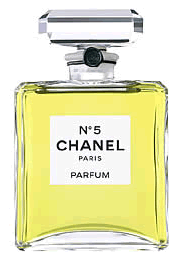The Chanel No. 5 Lesson
Experience precedes branding.
Do we all love the Nike logo because it’s inherently a great logo or do we love it because we’ve had good experiences with Nike shoes? How about the FedEx logo? The Apple logo? Chanel No. 5?
 Michael Bierut tackles this question in his great piece The Mysterious Power of Context over at Design Observer. He uses the example of how the word CHANEL is written in a very plain, sans-serif font that is quite boring on its own. But placed within the context of a Chanel bottle and our experiences with the perfume, the logo becomes powerful.
Michael Bierut tackles this question in his great piece The Mysterious Power of Context over at Design Observer. He uses the example of how the word CHANEL is written in a very plain, sans-serif font that is quite boring on its own. But placed within the context of a Chanel bottle and our experiences with the perfume, the logo becomes powerful.
Bierut suggests that we love the logos only after we’ve become accustomed to them, saying that it is the context in which we engage the logos that matter. I think Bierut is exactly right, and so in the tradition of the Del.icio.us Lesson,, I’m going to have some fun and call this the Chanel No. 5 Lesson. The Chanel No. 5 Lesson is that we have to experience something before we have strong feelings about it: that experience precedes branding.
Our first contact with a logo, if for a brand we aren’t familiar with, has little associated context. Therefore, we have no associated feelings with the logo and we won’t react strongly. We might react a little bit, but whatever our feelings about it will soon be overwhelmed by any direct experience. As our context changes over time, as we use the products and associate our experiences with the brand, then our feelings about it change as well. Bierut says:
‘In the world of identity design, very few designs mean anything when they’re brand new. A good logo, according to Paul Rand, provides the “pleasure of recognition and the promise of meaning.” The promise, of course, is only fulfilled over time. “It is only by association with a product, a service, a business, or a corporation that a logo takes on any real meaning,” Rand wrote in 1991. “It derives its meaning and usefulness from the quality of that which it symbolizes.’
This has huge implications for design! Bierut’s piece suggests that use is more important than image, because our image of something is based on actual experience. So, we don’t begin to like the Starbucks logo until after we’ve tasted their fantastic coffee, or experienced the brand in some other way. If the coffee was bad, then we would react negatively to the brand. It’s all about how our experience goes.
It could be argued that the logo and style of the brand affects the way we think about it, and could convince us that the brand is better than it is. I don’t think this is true, because people are smarter than that. People realize when they’re being duped, and if they have a bad experience with a product, no matter how great the packaging or branding is, they won’t stick around long enough to be convinced otherwise. There are thousands of brands out there with the potential to be considered great, with logos to match, but they just aren’t giving people what we want. So we use FedEx, Apple, and Chanel as examples and not them.
As much time as we spend making brands strong visually, we should spend double that from a usage point of view. If people have a good experience using a product, then creating a powerful brand around it will be a piece of cake.
Previous